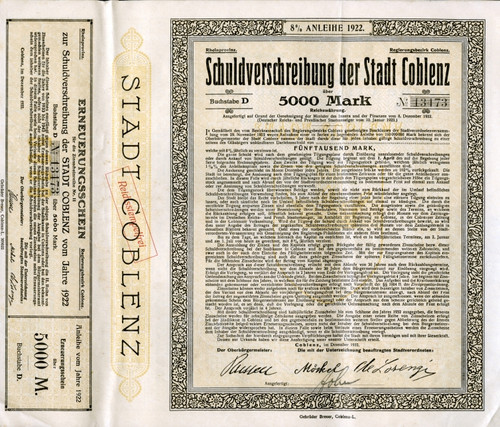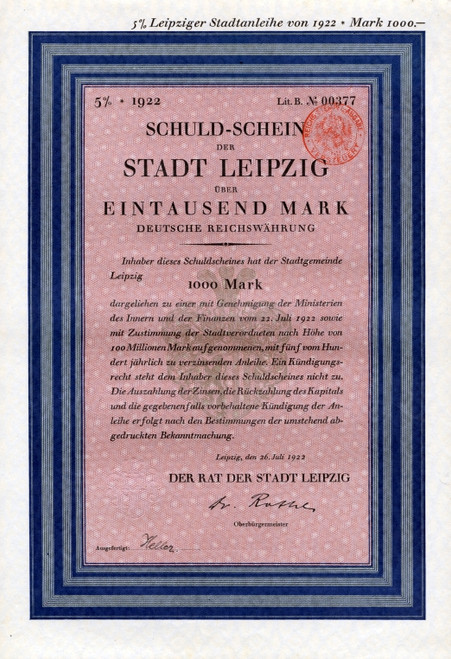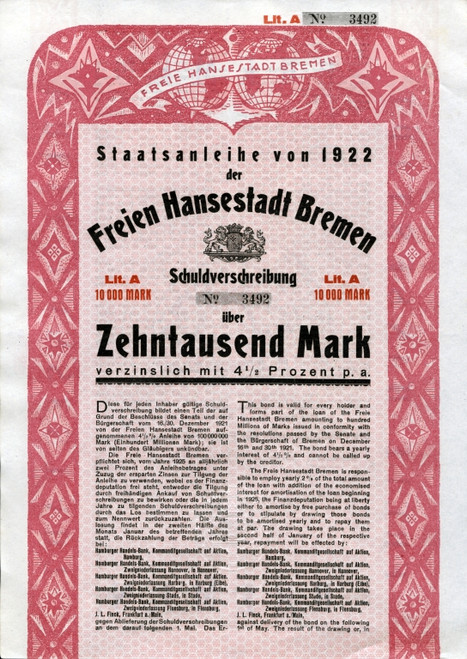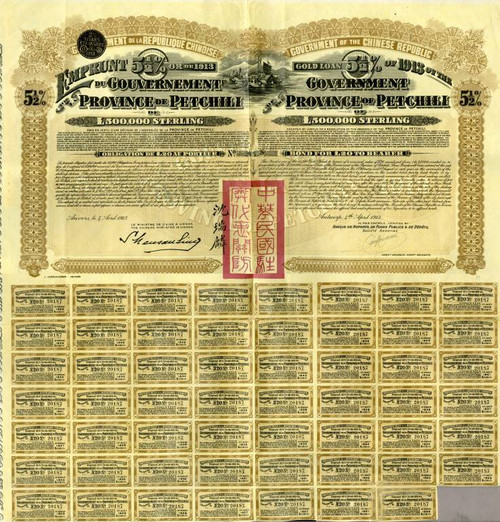Beautiful uncancelled certificate from the City of Darmstadt issued in 1922. This historic documenthas an ornate border around it with a vignette of city center. This item has the signatures of government officials. 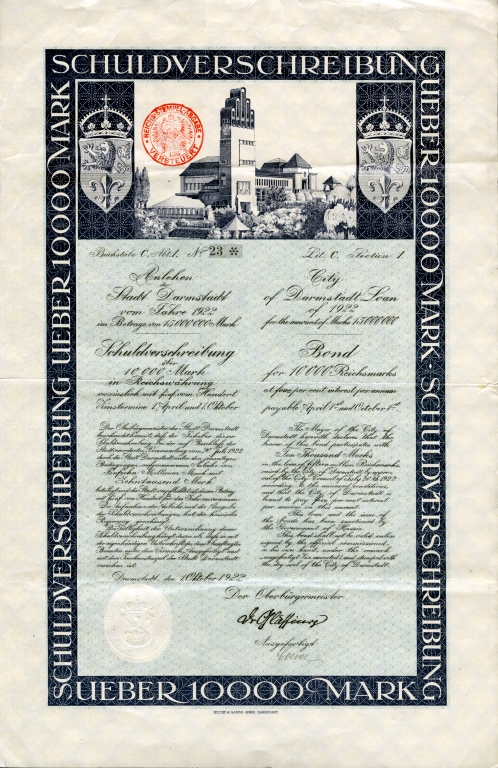
Certificate Darmstadt is a city in the Bundesland (federal state) of Hesse in Germany, located in the southern part of the Rhine-Main-Area (Frankfurt Metropolitan Region). Darmstadt has a population of 147,927 (2013). The Darmstadt Larger Urban Zone has 430,993 inhabitants. The sandy soils in the Darmstadt area, ill-suited for agriculture in times before industrial fertilisation, prevented any larger settlement from developing, until the city became the seat of the Landgraves of Hessen-Darmstadt in the 16th century. As the administrative centre of an increasingly prosperous duchy, the city gained in prominence during the following centuries. In the 20th century, industry (especially chemicals) as well as large science and electronics (later information technology) sectors became increasingly important, and are still a major part of the city's economy. Darmstadt also has a large tertiary education sector, with three major universities and numerous associated institutions.[5] Darmstadt is one of few cities in Germany which does not lie close to a river, lake or coast. The chemical element darmstadtium (atomic number 110) is named after it, having been synthesized in the GSI Centre for Heavy Ion Research in Darmstadt-Wixhausen. In 1965, the town hosted the fifth Hessentag state festival. The name Darmstadt first appears towards the end of the 11th century, then as Darmundestat. Literally translated, Darmstadt means "Intestine City", but this is just a coincidence. The origins of the name are unknown. 'Dar-mund' in Middle Low German is translated as "Boggy Headlands", but it could be a misspelling in local dialect of another name. Even locals often believe, incorrectly, that the name derives from the 'Darmbach' (a small stream formerly running through the city). In fact the stream received its current name much later, after the city, not vice versa. Darmstadt was chartered as a city by the Holy Roman Emperor Ludwig the Bavarian in 1330, at which time it belonged to the counts of Katzenelnbogen. The city, then called Darmstait, became a secondary residence for the counts, with a small castle established at the site of the current, much larger edifice. When the house of Katzenelnbogen became extinct in 1479, the city was passed to the Landgraviate of Hesse, and was seat of the ruling landgraves (15671806) and thereafter (to 1918) of the Grand Dukes of Hesse. The city grew in population during the 19th century from little over 10,000 to 72,000 inhabitants. A polytechnical school, which later became a Technical University now known as TU Darmstadt, was established in 1877. In the beginning of the 20th century Darmstadt was an important centre for the art movement of Jugendstil, the German variant of Art Nouveau. Annual architectural competitions led to the building of many architectural treasures of this period. Also during this period, in 1912 the chemist Anton Kollisch, working for the pharmaceutical company Merck, first synthesised the chemical MDMA (ecstasy) in Darmstadt. Darmstadt's municipal area was extended in 1937 to include the neighbouring localities of Arheilgen and Eberstadt, and in 1938 the city was separated administratively from the surrounding district (Kreis). Darmstadt was the first city in Germany to force Jewish shops to close in early 1933, shortly after the Nazis took power in Germany. The shops were only closed for one day, for "endangering communal order and tranquility". In 1942, over 3,000 Jews from Darmstadt were first forced into a collection camp located in the Liebigschule, and later deported to concentration camps where most eventually died. Some prominent members of the German resistance against the Nazis were citizens of Darmstadt. These include Wilhelm Leuschner and Theodor Haubach, both executed for their opposition to the regime. Darmstadt was first bombed on 30 July 1940, and 34 other air raids would follow. The old city centre was largely destroyed in a British bombing raid on 11 September 1944. This attack was an early use of the firestorm technique subsequently used on the city of Dresden in February 1945 where a number of incendiary bombs are dropped around the city before explosive blast bombs are dropped to begin a self-sustaining combustion process where the winds generated by the fire ensure it continues to burn. Darmstadt was selected as the secondary target for the raid, but promoted to primary target after clouds were observed over the primary which would have hindered any reconnaissance of the after-effects. During this worst attack an estimated 11,00012,500 inhabitants died, and 66,00070,000 were left homeless. Over three quarters of Darmstadt's inner city was destroyed. Post-war rebuilding was done in a relatively plain architectural style, although a number of historic buildings were rebuilt in their original styles after capturing the city in 20 March 1945 by 4th American Armored Division. Throughout the 19th and 20th centuries, Darmstadt became home to many technology companies and research institutes, and has been promoting itself as a "city of science" since 1997. It is well known as a high-tech centre in the vicinity of Frankfurt Airport, with important activities in spacecraft operations (the European Space Operations Centre, European Organisation for the Exploitation of Meteorological Satellites), chemistry, pharmacy, information technology, biotechnology, telecommunications (substantial Deutsche Telekom presence) and mechatronics. In 2000, its region also scored Rank 3 amongst 97 German regions in the WirtschaftsWoche test ranking Germany's high-tech regions. The TU Darmstadt is one of the important technical institutes in Germany and is well known for its research and teaching in the Electrical, Mechanical and Civil Engineering disciplines. Together with other tertiary institutions, the TU is responsible for the large student population of the city, which stood at 33,547 in 2004. Darmstadt is relatively typical for German cities in terms of its transport system, with the car being the main, but not overwhelmingly dominant mode of transport. Darmstadt is connected to the surrounding areas by a number of major roads, primarily accessing the areas to the north, west and south, including two Autobahn links crossing just west of the city as well as a BundesstraÃe also running north-south. The less settled areas east of the city in the Odenwald are accessed by several secondary roads. Darmstadt Hauptbahnhof is its main station, located at the western end of the central city and connects to the rest of Germany and Europe with the Intercity-Express network. There is also a much-utilised line S 3 of the Rhine-Main S-Bahn north to Frankfurt am Main and a number of suburban stations on the Main-Neckar Railway and two less important local rail lines, the Rhine-Main Railway to the east and the Odenwald Railway to the east, including Darmstadt Nord station. History from Encyberpedia, Wikipedia and OldCompany.com (old stock certificate research service)

Certificate





